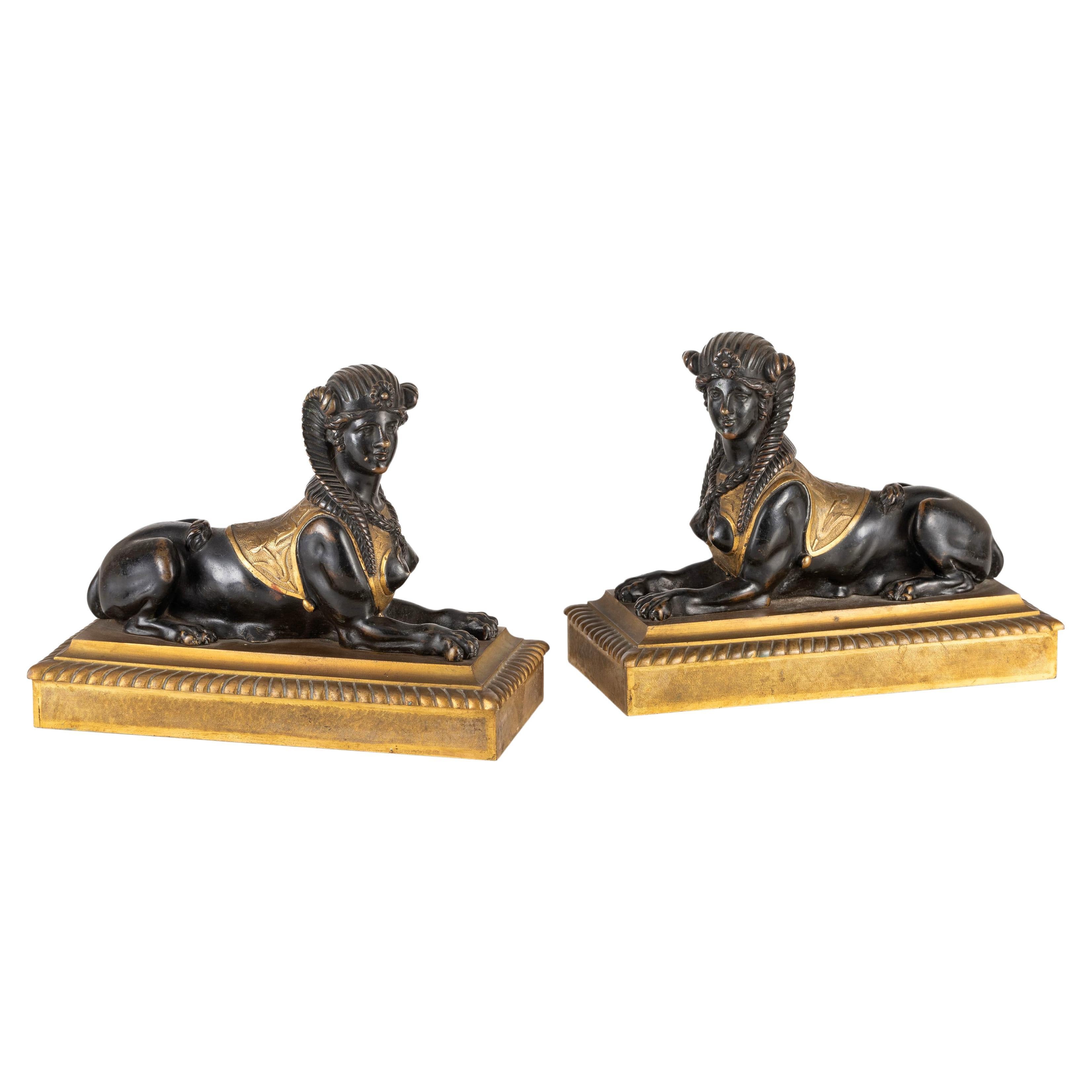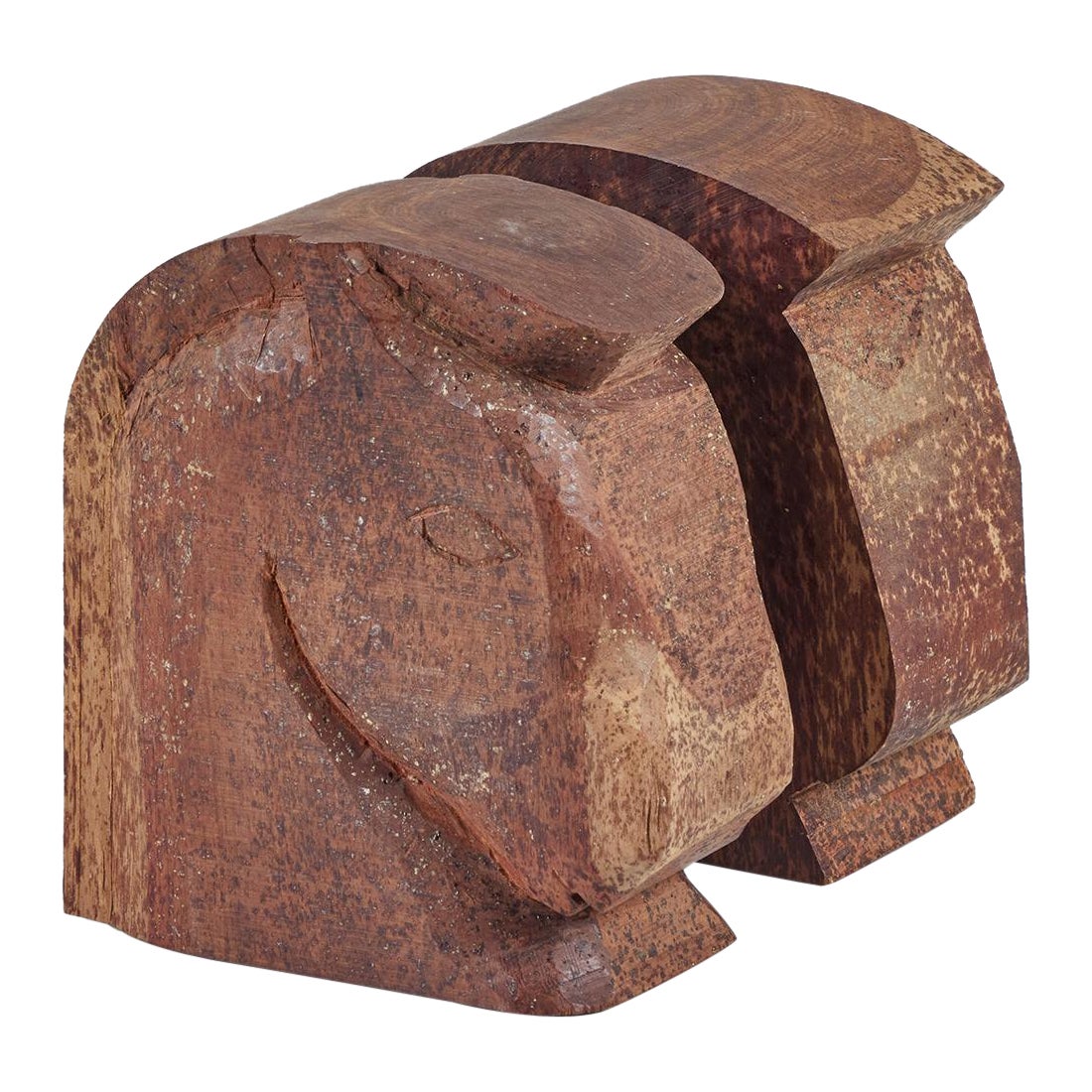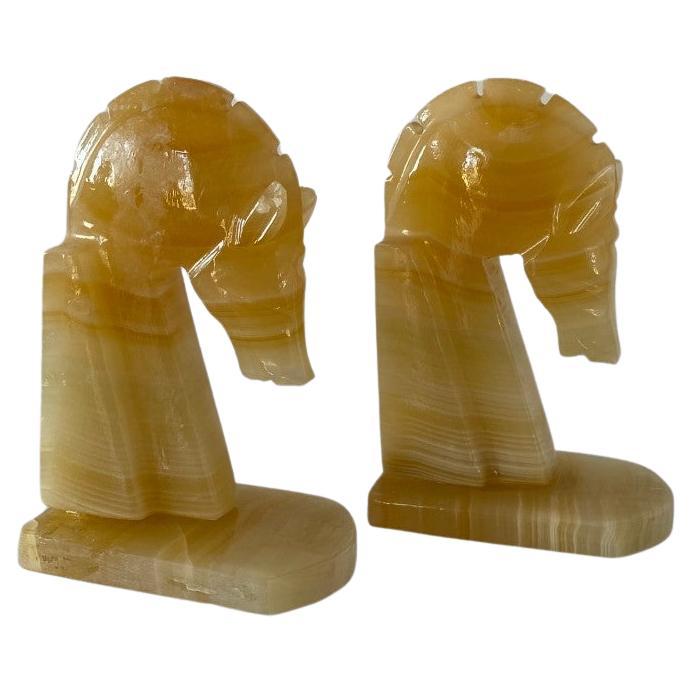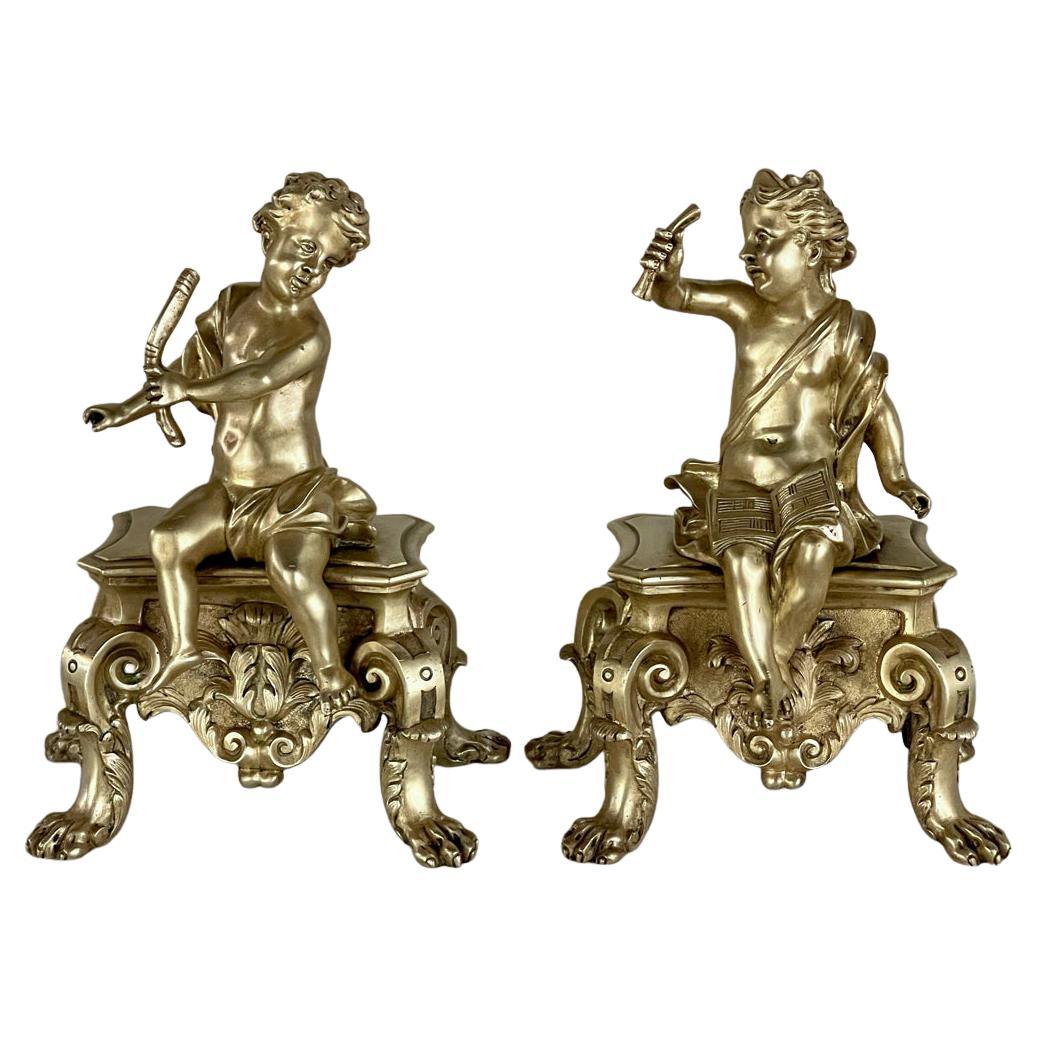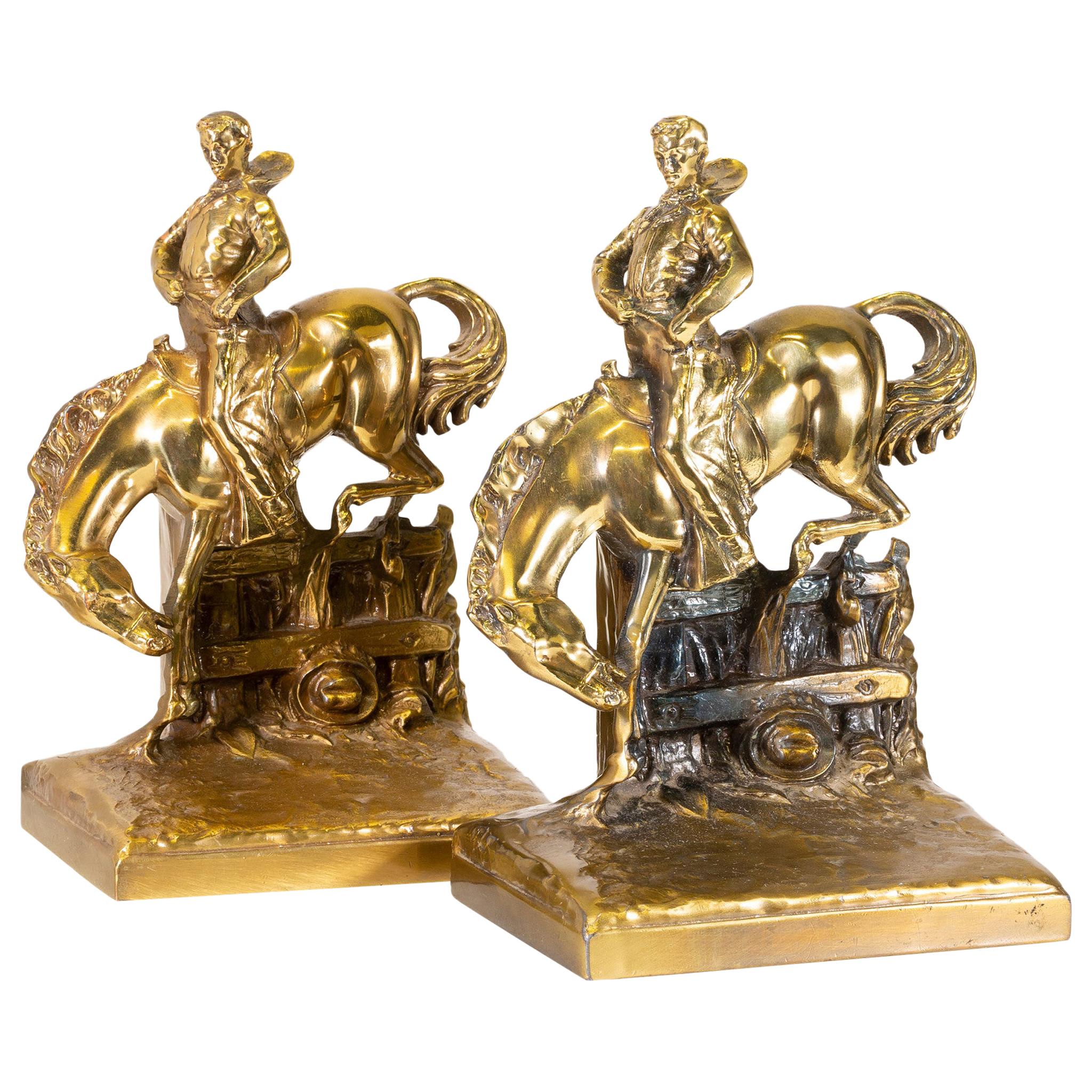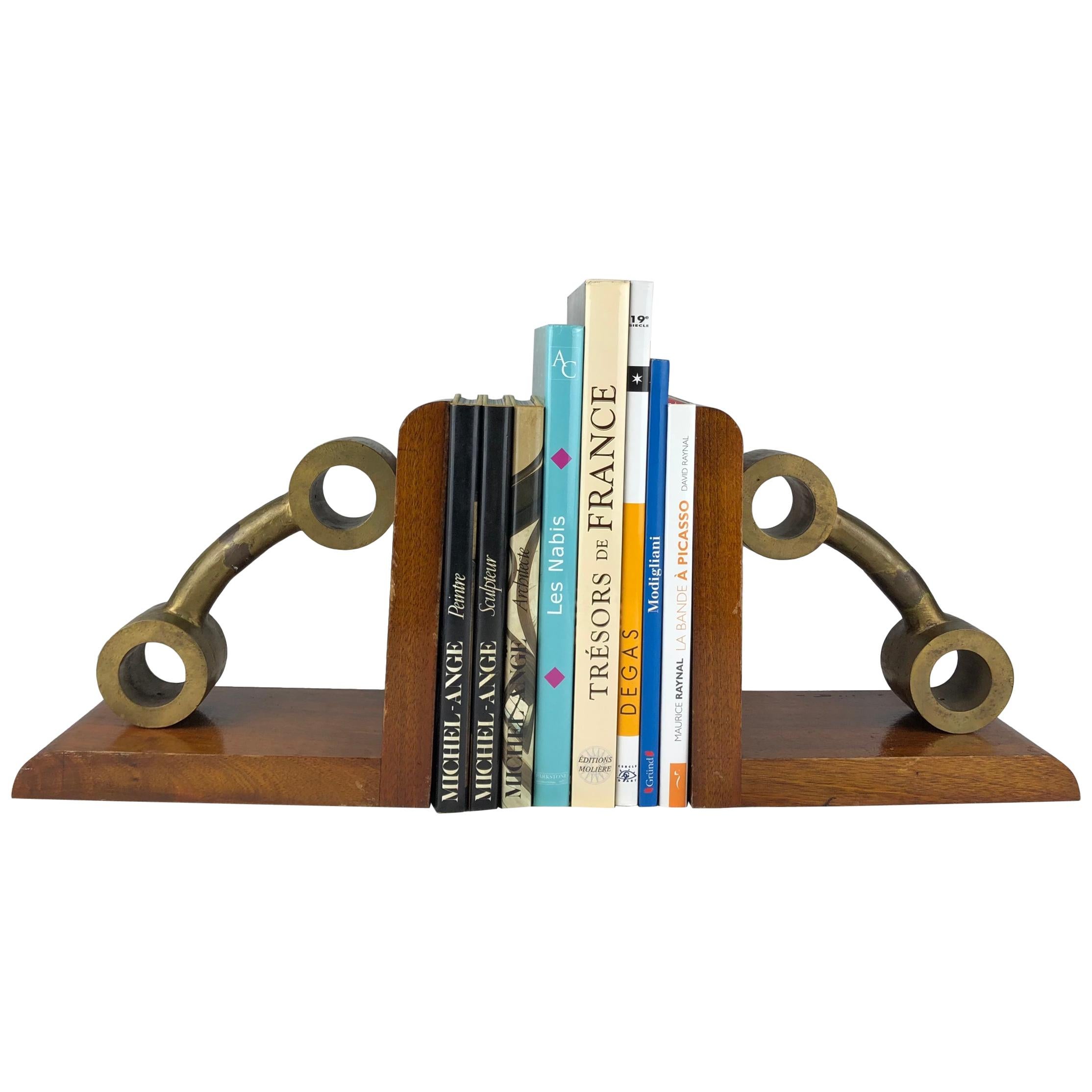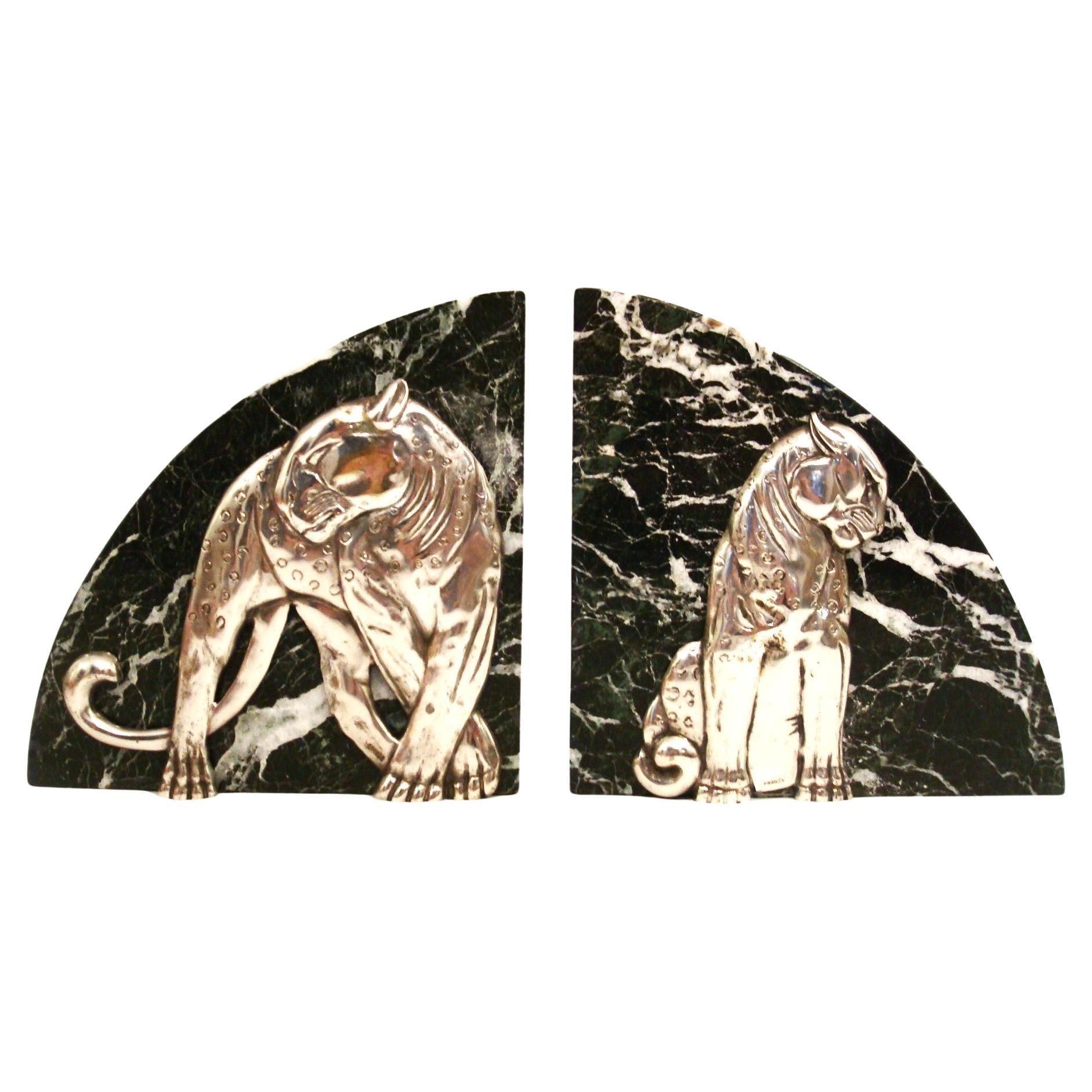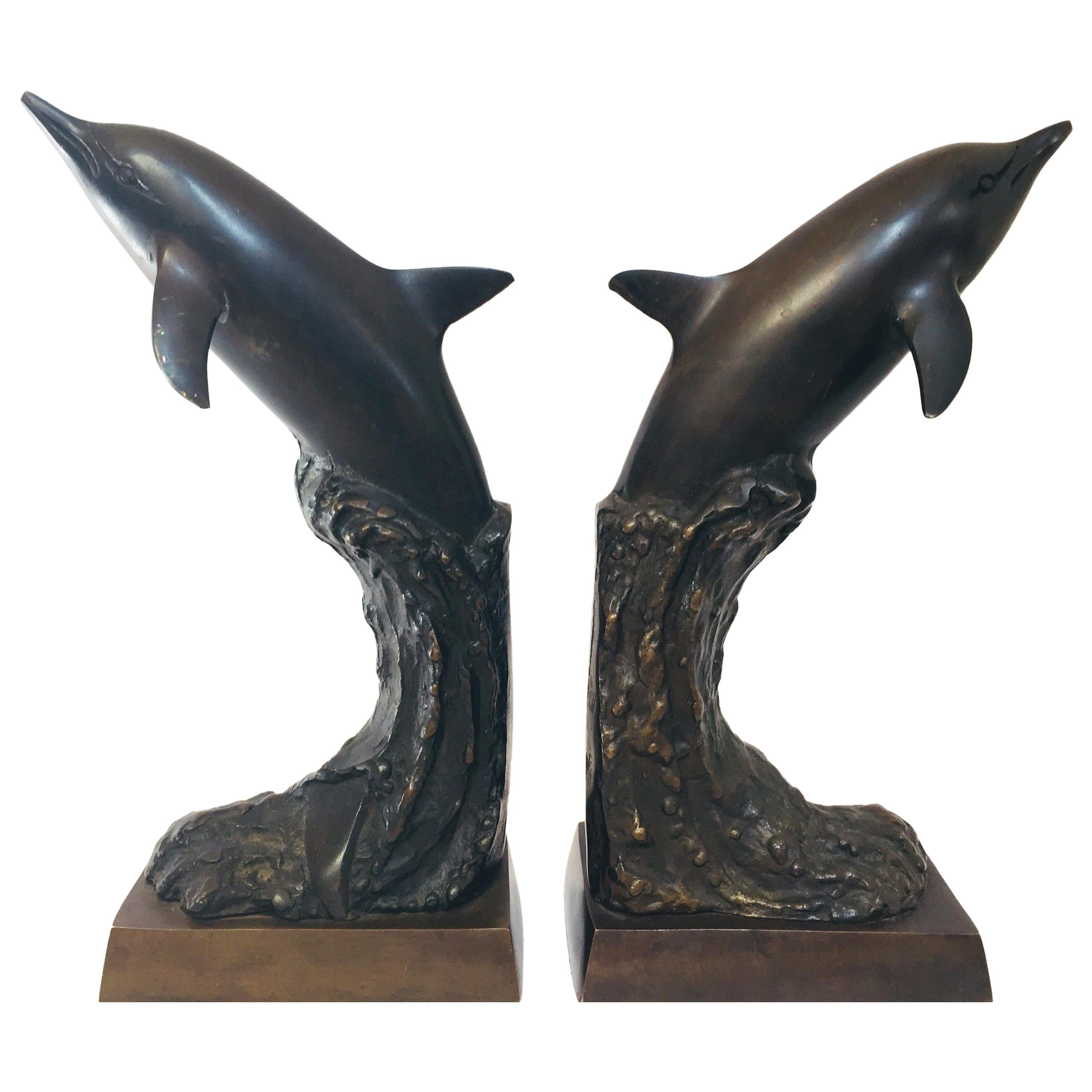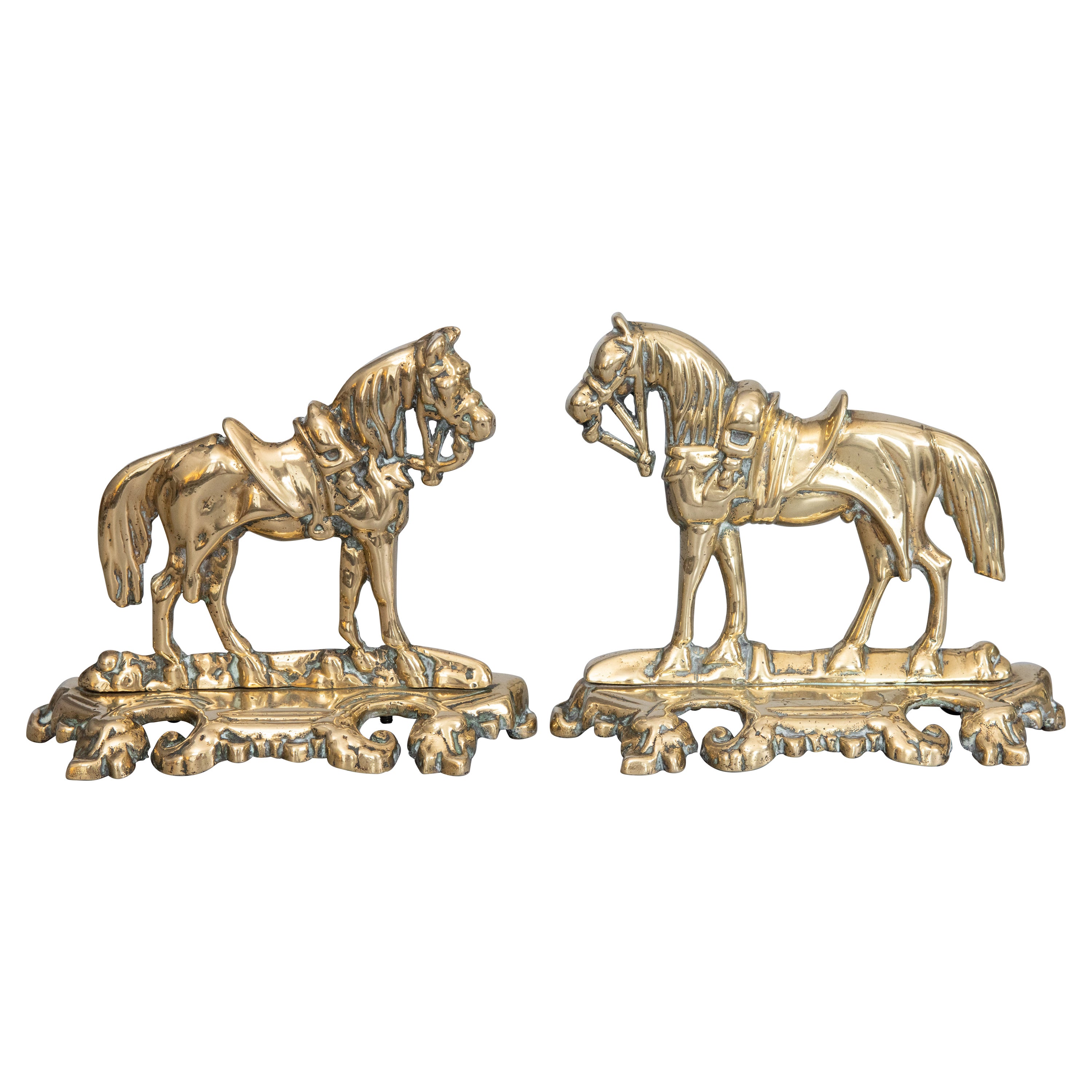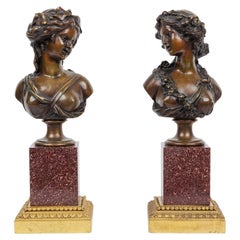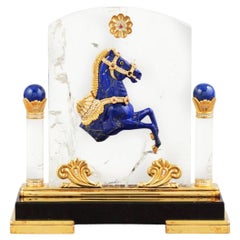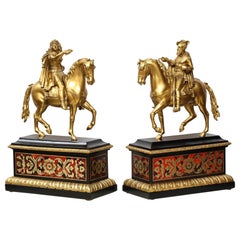
Pair of French Gilt Bronze Horse Riders on Ebony Boulle Bases
View Similar Items
Want more images or videos?
Request additional images or videos from the seller
1 of 14
Pair of French Gilt Bronze Horse Riders on Ebony Boulle Bases
About the Item
- Dimensions:Height: 16 in (40.64 cm)Width: 11 in (27.94 cm)Depth: 6 in (15.24 cm)
- Style:Napoleon III (Of the Period)
- Materials and Techniques:
- Place of Origin:
- Period:
- Date of Manufacture:circa 1890
- Condition:Wear consistent with age and use.
- Seller Location:New York, NY
- Reference Number:1stDibs: LU1798212974701
About the Seller
5.0
Vetted Seller
These experienced sellers undergo a comprehensive evaluation by our team of in-house experts.
Established in 1980
1stDibs seller since 2016
58 sales on 1stDibs
More From This SellerView All
- Pair of French Ormolu and Patinated Bronze Figural Busts on Porphyry BasesLocated in New York, NYA Pair of French Ormolu and Patinated Bronze Figural Busts on Porphyry Bases, circa 1875. One bust signed Marin, the other L.V.E Robert - a truly magnificent pair of busts...Category
Antique 19th Century French Napoleon III Figurative Sculptures
MaterialsPorphyry, Bronze, Ormolu
- Isidore-Jules Bonheur, A Rare Gilt and Patinated Bronze Jockey on A HorseBy Isidore Jules BonheurLocated in New York, NYIsidore-Jules Bonheur (French, 1827–1901) A Rare Gilt and Patinated Bronze Jockey on A Horse, circa 1875. Introducing a truly exceptional and highly s...Category
Antique 19th Century French Sporting Art Animal Sculptures
MaterialsBronze
- Mellerio Paris, A French Gold, Diamond, Silver-Gilt, Rock-Crystal, & Lapis HorseBy MellerioLocated in New York, NYMellerio Paris, A French Gold, Diamond, Silver-Gilt, Rock-Crystal, Obsidian & Lapis Horse An extremely rare and unique, one of a kind French gold, diamonds, Silver-gilt rock-crystal, obsidian and lapis lazuli jeweled sculpture "Bucéphale, Chevaux de légende", "Bucephalus, A Legendary Horse" by Mellerio, Paris, circa 1998. Sitting on black obsidian base, the solid rock crystal slab is finely applied with a lapis lazuli half-horse with harness mounted in 18k gold and brilliant cut diamonds, between two crystal and lapis lazuli columns adorned with gold and diamonds, insert with 7 ruby cabochons and 1 emerald cabochon, the obsidian base with a plaque engraved: CHEVAUX DE LEGENDE / MELLERIO DITS MELLER / PARIS / 5029 DIV Bucephalus (c355-326 BC) is among the most famous horses in history, and it was said that this he could not be tamed. The young Alexander the Great, of course, tamed him – and went on to ride his beloved equine companion for many years and into many battles. The piece is in excellent condition and comes with a custom made wood case made for transport. It's very elegant and has French hallmarks throughout. A truly magnificent piece. Measures 10" high x 9" wide x 4" deep Founded in France in 1613 by the descendants of Italian immigrants from the Vigezzo Valley in the north of Italy, Mellerio is one of the oldest jewellery houses in Europe. The family business soon attracted the attention of the Royal Court and Marie Antoinette herself reportedly purchased a precious bracelet featuring 7 cameos surrounded by rubies in 1780. Later on, in the 19th century, Mellerio became the official supplier of the French Royal family and the Court of Netherland. Mellerio creates many jewellery items, all set with rare gems such as peridots, amethysts, aquamarines, citrines and topaz, applying for a patent, the flexible stem, a very supple and light jewellery mechanism. Mellerio remains also well known for their spectacular series of Art Nouveau jewels, created at the beginning of the 20th century, as well as for the creation of trophies rewarding some of the greatest footfall and tennis players of history. In 1993, the jewellery house launched their first watch collection. Today, Mellerio has stores in Paris, Japan and Hong Kong. July 14, 1789: this date is known throughout the world as the beginning of the French Revolution. According to a ledger belonging to House of Mellerio, this was also the day that the jeweler sold a golden key to the Comte de Coutance for 10 livres. This ledger, as well as inventories dating as far back as 1768, are the jeweler’s oldest archives. These archives have continued to grow over the years, as the House, established on rue de la Paix in Paris, still lives on today, still in the hands of the same family from Craveggia, in the North of Italy. The tumultuous history of the Mellerio family in France probably goes as far back as the Italian wars of the Renaissance, but the first official document proving their commercial activity in Paris dates back to 1613. This document is the famous royal warrant awarded by Marie de Medici to a number of Italian families established along the rue des Lombards, including the Mellerios, allowing them to sell “small jewelery items”, therefore granting them a small exception to the traditional monopoly enjoyed by Parisian jewelers. At that time, powerful corporations regulated the operations and customs of Parisian business, but thanks to this exceptional warrant, the Mellerios managed to escape the confines of this framework. Today, this wax-sealed document is kept at the city hall of Craveggia. From 1613 to the Revolution, the Mellerios lived between France and Italy. The corporations tried many times to put an end to their trade privileges, but all in vain, as a dynasty of sovereigns renewed the warrant. Always marrying and often retiring in Craveggia, the Mellerios continued to maintain their jewelry business in Paris. At first, they did this without a shop. Wearing backpacks (wooden boxes divided into small compartments where jewels were kept), they would tour town fairs around Paris and royal castles. This is how Jean-Baptiste Mellerio (1765-1850) is said to have sold a bracelet set with rubies and Antique cameos to Marie-Antoinette, which still exists today. Many elements seem to prove the veracity of this anecdote. The queen was particularly fond of cameos, which cover the entire background of her famous jewelry cabinet, and ruby was her favorite stone after diamond. The famous bracelet, reacquired a few years ago by the House of Mellerio, is indeed an 18th century jewel, set with antique cameos representing the profiles of Roman emperors. Two branches of the family were operating in Paris during this time, under the reign of Louis XVI: that of Jean-François (1746-1828), the paternal ancestor of the current Mellerios, and that of Jean-Baptiste (1765-1850). The French Revolution forced them to return to Italy. However, both Jean-Baptiste and François Mellerio (1772-1843), who was the son of Jean-François, were eventually able to return to Paris after the founding of the Consulate. Jean-Baptiste opened a shop at the Iron Crown of rue Vivienne, and François opened his at the Palais des Tuileries, rue du Coq Saint-Honoré. His well-organized order books give an idea of his high-ranking clientele during the “Old Regime”, among which were the Comte and Comtesse Octave de Segur, the Marquise (later Duchess) de Tourzel, former governess of the royal children, and her daughter, the Comtesse de Bearn, the Craufurds -who organized the flight to Varennes, the Duc and Duchess de Gramont, the Comtesse de Boigne, and Madame de Souza, Talleyrand’s mistress. We also see the names of the imperial family: Empress Josephine, the Queen of Holland, Princess Elisa, Caroline and Pauline. At that time, the House of Mellerio specialized, among other things, in the trade of antique cameos, a newly fashionable genre of jewel that captured the imagination of all the princesses and noble women of the time. The years of the Restauration and July Monarchy were among the most glorious. The Bourbons were back on the throne, and the clientele of the House of Mellerio had regained its former wealth. Mellerio supplied Louis-Philippe, Duke of Orléans, as well as his mother, wife and sister, with sumptuous jewels, including a set of emeralds made piece by piece, while the Duke of Bourbon, last prince of the House of Condé, offered diamonds to his mistress, the scheming Baronne de Feucheres, and Monsieur de LaFayette also bought cameos for one of his granddaughters. For the first time, Mellerio ventured into the world of arts in 1815, when Carlotta Grisi, a famous dancer who created Giselle, as well as an actress named Rachel, bought jewels at the Mellerio store on rue de la Paix. 1848 marked a new turning point. France once again became a Republic. François Mellerio handed the company over to his son, Jean, and the latter decided to travel to Spain to build a new clientele. He later became one of the jewelers of the royal family, and met Eugénie de Montijo, who remained a faithful client when she became empress of the French people. The Imperial years were lavish. During the Second Empire, Paris was a pageant of crinoline dresses designed by Worth, while jewels by Mellerio, Worth’s neighbour on the rue de la Paix, adorned the noble women of the Tuileries court. The Empress bought pearls. Mathilde Bonaparte...Category
20th Century French Mounted Objects
MaterialsLapis Lazuli, Rock Crystal, Gold, Silver
- Monumental French Patinated Bronze Bust of William Shakespeare, After HoudonBy F. Barbedienne FoundryLocated in New York, NYA monumental French patinated bronze bust of William Shakespeare, after Houdon, by F. Barbedienne Foundry, circa 1870. Masterfully and realistically sculpted in solid bronze, this...Category
Antique 19th Century French Napoleon III Busts
MaterialsBronze
- Monumental Silvered and Gilt-Bronze Glass Centerpiece of "Poseidon"Located in New York, NYA Monumental French Silvered and Gilt-Bronze and Glass Centerpiece of "Poseidon", Paris, circa 1895. A very good quality centerpiece depicting "Poseidon and his seahorses", of mon...Category
Early 20th Century French Classical Greek Centerpieces
MaterialsBronze
- Palatial & Rare Napoleon III French Ormolu and Patinated Bronze Clock, DetoucheBy C. DetoucheLocated in New York, NYA palatial, extremely rare, and important Napoleon III French ormolu and patinated bronze regulateur de parquet clock, by Louis-Constantin Detouche, Paris, circa 1850. The clock case made form the finest French ormolu, with 2 very large patinated bronze seated putti The white enamel dial Signed C. DETOUCHE/ PARIS. The clock movement is numbered 7064 and stamped with maker’s stamps C. Detouche RUE st. MARTIN and C. DETOUCHE 158 R. St MARTIN 160, with medaille d’argent stamp, on a serpentine part ebonized mahogany plinth. At over six feet tall, the present clock is impressive in scale and rare in Detouche’s oeuvre. While other large clocks were produced by the firm, few of this scale are so overtly decorative and usually incorporate greater mechanical complication. For example, a gilt bronze astronomical regulator clock...Category
Antique 19th Century French Napoleon III Grandfather Clocks and Longcase...
MaterialsBronze, Ormolu
You May Also Like
- Art Deco Bookends Swans Bronzed Metal on Beige Marble Bases, French, circa 1930Located in Lincoln, LincolnshireThese are a beautiful pair of good quality French, Art Deco period, book ends of two metal bronzed swans on marble bases. Each swan has been well modelled with good detail and th...Category
Early 20th Century French Art Deco Bookends
MaterialsMarble, Metal
- 19th Century, Pair of French Empire Gilt and Patinated Bronze Sculptures SphinxeLocated in IT19th century, Pair of French Empire Gilt and Patinated Bronze Sculptures Sphinxes This pair of decorative elements was made in F...Category
Antique Early 19th Century French Empire Figurative Sculptures
MaterialsBronze
- Pair of Wood Horse Head BookendsLocated in Los Angeles, CAA pair of solid wood bookends hand carved into the shape of horse heads. One bookend features a carved horse head profile while the other appears more as the shadow. A playful piece ...Category
Mid-20th Century American Mid-Century Modern Bookends
MaterialsWood
Sold$400 / set - Greco Roman Fighters Gilt Bronze Bookends, France, 1920By FrecourtLocated in Buenos Aires, OlivosVery nice Greco Roman fighters bookends. Statues made of gilt bronze. Bases signed Frecourt and France. The figures are different one from the other.Category
Early 20th Century French Greco Roman Bookends
MaterialsBronze
$1,840 Sale Price / set20% Off - Pair of Midcentury Marble Horse Head BookendsLocated in San Diego, CAStylish pair of midcentury marble horse head bookends, circa 1970s. The bookends are heavy and well crafted, they are honey cream in color w...Category
Mid-20th Century Greek Mid-Century Modern Bookends
MaterialsMarble
- Gilt Bronze Native North American Indians Bookends, France, 1920By Antoine BofillLocated in Buenos Aires, OlivosFantastic bronze bookends. Gilt bronze sculptures of North American native tribal chief. Mounted over green marble. Signed A. Bofill and numbered 35 an...Category
20th Century French Art Deco Figurative Sculptures
MaterialsMarble, Bronze
$1,899 Sale Price / set57% Off
Recently Viewed
View AllMore Ways To Browse
Bronze Horse Rider Sculpture
Napoleon Horse
Antique Bronze Horse And Rider
Jupiter Statuette
Evgeniy Vuchetich
Gold Leaf Sculpture
Lorenzo Bronze
Man Austrian Bronze
Female Ceramic Sculpture
Porcelain Figure Black
Little Girl Room Furniture
Hand Painted Bronze
Greek Type
Lalique Falcon
Retro Wolf Dress Form
Taoist Master Wood Statue
Vintage Porcelain Ballerina Figurines
Yves Lohe

